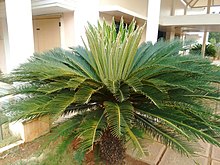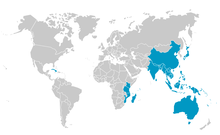Cycas
| Cycas Temporal range:
| |
|---|---|

| |
| A large cycas under development | |
| Scientific classification | |
| Kingdom: | Plantae |
| Clade: | Tracheophytes |
| Clade: | Gymnospermae |
| Division: | Cycadophyta |
| Class: | Cycadopsida |
| Order: | Cycadales |
| Suborder: | Cycadineae |
| Family: | Cycadaceae Pers.[2] |
| Genus: | Cycas L.[1] |
| Type species | |
| C. circinalis[1] L.[1]
| |

| |
| Synonyms[3] | |
| |
Cycasis a genus ofcycad,and the only genus in the familyCycadaceaewith all other genera of cycad being divided between the Stangeriaceae and Zamiaceae families.Cycas circinalis,a species endemic to India, was the first cycad species to be described in western literature, and is thetype speciesof the genus.[4][5]
As of April 2024, there are 119 acceptedspecieswithin the genusCycas,all of which are native toAsia,Oceania, and eastern Africa and the Indian ocean region, with the largest number of species native to Australia, China and Vietnam.[6][7][8]
In horticulture, the most widely grown and perhaps best-knownCycasspecies isCycas revoluta,which is commercially grown in large numbers for sale as houseplants or to be used in landscaping.[8][9][10]
The majority ofCycasspecies are highly endangered. Many are threatened by the illegal trade of wild collected plants for plant collectors, and through the conversion of land for urban development or agricultural use.[8]
Range
[edit]The genusCycasis native to parts ofAsia,easternAfricaandOceania.[8]Cycashas the widest distribution of any genus of cycad.[11]
In Asia,Cycas(and therefore, the family Cycadaceae) represent the only cycads native to Asia. Within Asia,Cycasspecies are native fromIndiaandSri Lankain the west, throughChinatoJapanin the north east and through south east Asia (including thePhilippines) toIndonesiain the south. Globally, the northernmost species (Cycas revoluta) is found at 31°N in southern Japan.[8][9]
As of April 2024, the largest number of currently accepted species ofCycasin Asia are found in Vietnam (27 species), China (23 species), India (14 species), Thailand (12 species), Philippines (12 species) and Indonesia (10 species).[7]The distribution of Cycas species inMyanmar,Laos,andCambodiais not well known, but as of April 2024, no accepted cycad species is known to be endemic to any of these three countries.[7][8]
In Africa, cycads belonging to all three cycad families are found making it a major center of diversity for cycads in general, but only oneCycasspecies (Cycas thouarsii)is native and it is restricted to eastern Africa and nearby island nations.C. thouarsiigrows in a comparatively wide area including coastal regions ofMozambique,Tanzania,andKenyain mainland Africa, extending to theSeychelles,MadagascarandComorosislands in theIndian Ocean.[8][12]
In Oceania,Cycasspecies are native toAustralia,Papua New Guinea,and the island nations of thePacific Oceanregion, but are absent fromNew Zealand.As in Asia,Cycasis the only genus of cycad found across the region, with the exception for Australia, where cycads native to all three families of cycads are found. Despite this, Australia also has the largest number ofCycasspecies globally with 34 nativeCycasspecies accepted (as of April 2024), including the southernmost species globally (Cycas megacarpa) found at 26°S in southeastQueensland.[7][8][13]At least 7Cycasspecies are found inPapua New Guinea,some of which are also found in parts of neighbouringIndonesia.[7]In the broader region,Cycas seemanniiis found inMelanesiaand westernPolynesiaandCycas micronesicais found acrossMicronesia.[8][14][15]
Globally, someCycasspecies are considered to be relatively widespread, for exampleCycas thouarsiiis native to a large area of mainland Africa and islands of the Indian Ocean, andCycas pectinataandCycas clivicolaare both native to large areas of Asia; however, mostCycasspecies have restricted distributions, with some restricted to very small areas. In Asia, for example, more than 75% of species occur in no more than one country. For some countries, even though the number of species may not be high, the level of species-specific genetic variation can be very high meaning that so that even countries with few species, it may contain distinct gene pools of widespread species.[8][16]
Evolution
[edit]
Cycas(and the Cycadaceae family) is considered as being an early offshoot that diverged early from all other living cycads (which belong to the familyZamiaceae). Estimates of the timing of the split ranging from theJurassic[17]to theCarboniferous.[18]The earliestfossilsassignable toCycasare known from thePaleogeneof East Asia, such asCycas fushunensisfrom theEocene(around 47.5 million years ago) ofNortheast Chinawith East Asia likely representing the ancestral homeland of the genus.[19]The presence ofCycasin Australasia and eastern Africa is relatively new, but the major evolutionary events behind the genesis of new species have taken place in Indochina and Australia, where the majority of living species are native.[8]
Fossil seeds from the Middle Jurassic of England and British Columbia were suggested in a 2017 study to be more closely related toCycasthan other cycads and were assigned to the same family, Cycadaceae.[20]A later study suggested that these seeds could not be assigned to thestem-groupofCycaswith confidence due to lacking the double vascular system that characterises the seeds of all living cycads.[21]The leaf fossil genusParacycasknown from the Jurassic and Cretaceous of Europe has been suggested to be early representatives of theCycaslineage bycladisticanalysis.[18]
Morphology
[edit]
The plants aredioecious,and the family Cycadaceae is unique among the cycads in not forming seedconeson female plants, but rather a group of leaf-like structures called megasporophylls each with seeds on the lower margins, and pollen cones or strobilus on male individuals.
Thecaudexis cylindrical, surrounded by the persistentpetiolebases. Most species form distinct branched or unbranched trunks but in some species the main trunk can be subterranean with the leaf crown appearing to arise directly from the ground. There are two types of leaves - foliage leaves and scaly leaves. The foliage leaves arepinnate(or more rarely bipinnate) and arranged spirally, with thick and hardkeratinose.[clarification needed]They are not permanent and fall off leaving back leaf-bases. The leaflets are articulated, have midrib but lack secondary veins. The scaly leaves are persistent, brown in colour and protective in function.Megasporophyllsare not gathered in cones.Pollinationtakes place by air.
Reproduction
[edit]
Cycas take about 10 years to reach sexual maturity, after years of exclusive vegetative growth, which occurs by bulbils arising at the base of the trunk.[citation needed]
Conservation status
[edit]Cycasspecies are threatened worldwide and almost all the species are listed in theIUCN Red List.Cycas beddomeiis the only species of the genusCycaslisted in Appendix I of CITES. All other members ofCycadaceaeare listed under Appendix II.[22]Cycas rumphiiandCycas pectinatahave the most widespread distribution.
Phylogeny
[edit]


| Phylogeny ofCycas[23] | ||||||||||||||||||||||||||||||||||||||||||||||||||||||||||||||||||||||||||||||||||||||||||||||||||||||||||||||||||||||||||||||||||||||||||||||||||||||||||||
|---|---|---|---|---|---|---|---|---|---|---|---|---|---|---|---|---|---|---|---|---|---|---|---|---|---|---|---|---|---|---|---|---|---|---|---|---|---|---|---|---|---|---|---|---|---|---|---|---|---|---|---|---|---|---|---|---|---|---|---|---|---|---|---|---|---|---|---|---|---|---|---|---|---|---|---|---|---|---|---|---|---|---|---|---|---|---|---|---|---|---|---|---|---|---|---|---|---|---|---|---|---|---|---|---|---|---|---|---|---|---|---|---|---|---|---|---|---|---|---|---|---|---|---|---|---|---|---|---|---|---|---|---|---|---|---|---|---|---|---|---|---|---|---|---|---|---|---|---|---|---|---|---|---|---|---|---|
|
Other species:
- Cycas a EnigmaHill & Lindström
- Cycas apoaHill
- Cycas arnhemicaHill
- Cycas badensisHill
- Cycas bglswamyiPant ex Agrawal, Akhtar & R.C.Srivast.
- Cycas brunneaHill
- Cycas campestrisHill
- Cycas candidaHill
- Cycas cantafoliaJutta, Chew & Saw
- Cycas chang gian gensisLiu
- Cycas cheniiGong & Zhou
- Cycas collinaHill, Nguyên & Lôc
- Cycas cupidaForster
- Cycas darshiiSrivastava & Jana
- Cycas desolataForster
- Cycas dharmrajiiSingh
- Cycas distansP.I.Forst. & B.Gray
- Cycas divyadarshaniiKhuraijam & Rita Singh
- Cycas elephantipesLindström & Hill
- Cycas falcataHill
- Cycas flabellataAgoo, Madulid & Callado
- Cycas fugaxHill, Nguyên & Lôc
- Cycas furfuraceaW.Fitzg.
- Cycas glaucaMiquel
- Cycas hoabinhensisLôc & Nguyên
- Cycas inermisOudem.
- Cycas javana(Miquel) de Laubenfels
- Cycas lacrimansLindström & Hill
- Cycas lane-poolei
- Cycas laoticaNguyên & Nguyên
- Cycas litoralisHill
- Cycas mindanaensisAgoo, Madulid & Callado
- Cycas miqueliiWarburg
- Cycas montanaLindström & Hill
- Cycas nayagarhensisRita Singh, Radha & Khuraijam
- Cycas nathorstiiSchuster
- Cycas orixensis(Haines) Rita Singh & Khuraijam
- Cycas pachypodaHill
- Cycas panzhihuaensisZhou & Yang
- Cycas papuanavon Mueller
- Cycas pectinata
- Cycas pranburiensisYang et al.
- Cycas pruinosaMaconochie
- Cycas sainathiiSrivastava
- Cycas sancti-lasalleiAgoo & Madulid
- Cycas saxatilisHill & Lindström
- Cycas scratchleyanavon Mueller
- Cycas seemanniiA.Braun
- Cycas seshachalamensisRao et al.
- Cycas sexseminiferaWei
- Cycas shanyaensisFu
- Cycas sundaicaMiquel ex Lindström & Hill
- Cycas terryanaForster
- Cycas tuckeriHill
- Cycas xipholepisHill
- Cycas yorkianaHill
- Cycas yunnanensisCheng, Fu & Cheng
- Cycas zambalensisMadulid & Agoo
- Cycas zeylanica(Schuster) Lindström & Hill
References
[edit]- ^abcHill, Ken; Leonie Stanberg; Dennis Stevenson."The Cycad Pages".Genus Cycas.Royal Botanic Gardens Sydney. Archived fromthe originalon 2021-03-01.Retrieved6 September2013.
- ^Johnson, L. A. S.; Wilson, K. L. (1990). "Cycadaceae".Pteridophytes and Gymnosperms.p. 370.doi:10.1007/978-3-662-02604-90.0.ISBN978-3-642-08080-7.
- ^"CycasL. "Plants of the World Online.Royal Botanic Gardens, Kew.Retrieved28 March2023.
- ^Linnaeus, Carl (1753).Palmae Pennatifoliae. Cycas [Cycas circinalis protologue].pp. Sp. Pl. 2: 1188.
- ^Type Location(s): LT:t. 19, in Rheede, Hort. Malab, 3 (1682) Cycas circinalis at The World List of Cycads(cycadlist.org)
- ^119 accepted species, with 6 infraspecific taxa, as of April 21, 2024.
- ^abcdeThe World List of Cycads (WLoC), a comprehensive taxonomic reference for cycad taxonomy, nomenclature, biology, and literature. The WLoC is produced under the auspices of theIUCN/SSC Cycad Specialist Group (CSG).The online edition is hosted and sponsored byMontgomery Botanical Center. Calonje M, Stevenson DW, Osborne R. The World List of Cycads, online edition [Internet]. 2013-2024. [cited 2024 Apr 21]. Available from:http:// cycadlist.org.
- ^abcdefghijkDonaldson, J.S.; Dehgan, B.; Vovides, A.P.; Tang, W. (2003)."Cycads in trade and sustainable use of cycad populations"(PDF).Cycads Status Survey and Conservation Action Plan.IUCN The World Conservation Union Gland, Switzerland.
- ^ab"Cycas revoluta".cycadlist.org.Retrieved2024-04-21.
- ^Marler, Thomas E.; Moore, Aubrey (May 2010)."Cryptic Scale Infestations on Cycas revoluta Facilitate Scale Invasions".HortScience.45(5): 837–839.doi:10.21273/HORTSCI.45.5.837.
- ^Hill, K. D. (2004). Character evolution, species recognition and classification concepts in the Cycadaceae In Walters T., & Osborne R. (Eds.),Cycad classification, concepts and recommendations(pp. 23–44). Wallingford: CABI Publishing.Available as a PDF online at:cabidigitallibrary.org
- ^"Cycas thouarsii".cycadlist.org.Retrieved2024-04-21.
- ^"Cycas megacarpa".cycadlist.org.Retrieved2024-04-21.
- ^"Cycas seemannii".cycadlist.org.Retrieved2024-04-21.
- ^"Cycas micronesica".cycadlist.org.Retrieved2024-04-21.
- ^Xiao, Siyue; Ji, Yunheng; Liu, Jian; Gong, Xun (February 2020)."Genetic characterization of the entire range of Cycas panzhihuaensis (Cycadaceae)".Plant Diversity.42(1): 7–18.doi:10.1016/j.pld.2019.10.001.PMC7046506.PMID32140633.
- ^Nagalingum, N. S.; Marshall, C. R.; Quental, T. B.; Rai, H. S.; Little, D. P.; Mathews, S. (11 November 2011). "Recent Synchronous Radiation of a Living Fossil".Science.334(6057): 796–799.Bibcode:2011Sci...334..796N.doi:10.1126/science.1209926.PMID22021670.S2CID206535984.
- ^abCoiro, Mario; Allio, Rémi; Mazet, Nathan; Seyfullah, Leyla J.; Condamine, Fabien L. (2023-06-11)."Reconciling fossils with phylogenies reveals the origin and macroevolutionary processes explaining the global cycad biodiversity".New Phytologist.240(4): 1616–1635.doi:10.1111/nph.19010.ISSN0028-646X.PMC10953041.PMID37302411.S2CID259137975.
- ^Liu, Jian; Lindstrom, Anders J; Marler, Thomas E; Gong, Xun (28 January 2022)."Not that young: combining plastid phylogenomic, plate tectonic and fossil evidence indicates a Palaeogene diversification of Cycadaceae".Annals of Botany.129(2): 217–230.doi:10.1093/aob/mcab118.PMC8796677.PMID34520529.
- ^Spencer, Alan R. T.; Garwood, Russell J.; Rees, Andrew R.; Raine, Robert J.; Rothwell, Gar W.; Hollingworth, Neville T. J.; Hilton, Jason (2017-08-28)."New insights into Mesozoic cycad evolution: an exploration of anatomically preserved Cycadaceae seeds from the Jurassic Oxford Clay biota".PeerJ.5:e3723.doi:10.7717/peerj.3723.ISSN2167-8359.PMC5578371.PMID28875075.
- ^Rothwell, Gar W.; Stockey, Ruth A.; Stevenson, Dennis W.; Zumajo-Cardona, Cecilia (October 2022). "Large Permineralized Seeds in the Jurassic of Haida Gwaii, Western Canada: Exploring the Mode and Tempo of Cycad Evolution".International Journal of Plant Sciences.183(8): 674–690.doi:10.1086/721710.hdl:2434/975729.
- ^"Appendices I, II and III".Convention on International Trade in Endangered Species of Wild Fauna and Flora.21 May 2023.Retrieved22 August2023.
- ^Stull, Gregory W.; Qu, Xiao-Jian; Parins-Fukuchi, Caroline; Yang, Ying-Ying; Yang, Jun-Bo; Yang, Zhi-Yun; Hu, Yi; Ma, Hong; Soltis, Pamela S.; Soltis, Douglas E.; Li, De-Zhu; Smith, Stephen A.; Yi, Ting-Shuang (19 July 2021). "Gene duplications and phylogenomic conflict underlie major pulses of phenotypic evolution in gymnosperms".Nature Plants.7(8): 1015–1025.Bibcode:2021NatPl...7.1015S.doi:10.1038/s41477-021-00964-4.PMID34282286.
External links
[edit]- de Laubenfels, D.J.; Adema, F. (1998)."A taxonomic revision of the generaCycasandEpicycasGen. Nov. (Cycadaceae) ".Blumea.43:351–400.
- Hill, K.D.(1998–2004) The Cycad Pages, Royal Botanic Gardens Sydney.http://plantnet.rbgsyd.nsw.gov.au/PlantNet/cycad/index.htmlArchived2021-03-29 at theWayback Machine
- Virtual Cycad Encyclopediaedited by the Palm & Cycad Societies of Florida
- David, J. de Laubenfels,Cycas Taxonomy
- Hill, K.D.; Stevenson, Dennis W.; Osborne, Roy (2004). "The World List of Cycads".The Botanical Review.70(2): 274–298.doi:10.1663/0006-8101(2004)070[0274:TWLOC]2.0.CO;2.S2CID36921733.
- Lindstrom, Anders J.; Hill, Ken D. (2007)."The genusCycas(Cycadaceae) in India ".Telopea.11(4): 463–488.doi:10.7751/telopea20075745.
- Singh, R & JS Khuraijam (2013-) Cycads of India.http:// cycadsofindia.in/Archived2021-01-18 at theWayback Machine
- Singh, R.; Radha, P.; Khuraijam, J.S. (2015). "A new species, a new combination and a new subsection of Cycas from Odisha, northern Eastern Ghats of India".Asian Journal of Conservation Biology.4(1): 3–14.
- Singh, R.; Radha, P. (2006). "Cycas annaikalensis,A new species ofCycasfrom the Malabar Coast, Western Ghats, India ".Brittonia.58(2): 119–123.doi:10.1663/0007-196x(2006)58[119:ansocf]2.0.co;2.S2CID32241023.
- Terrence Walters & Roy Osborne (eds.) (2004),Cycad Classification: Concepts and Recommendations,CABI publishing,ISBN0-85199-741-4


